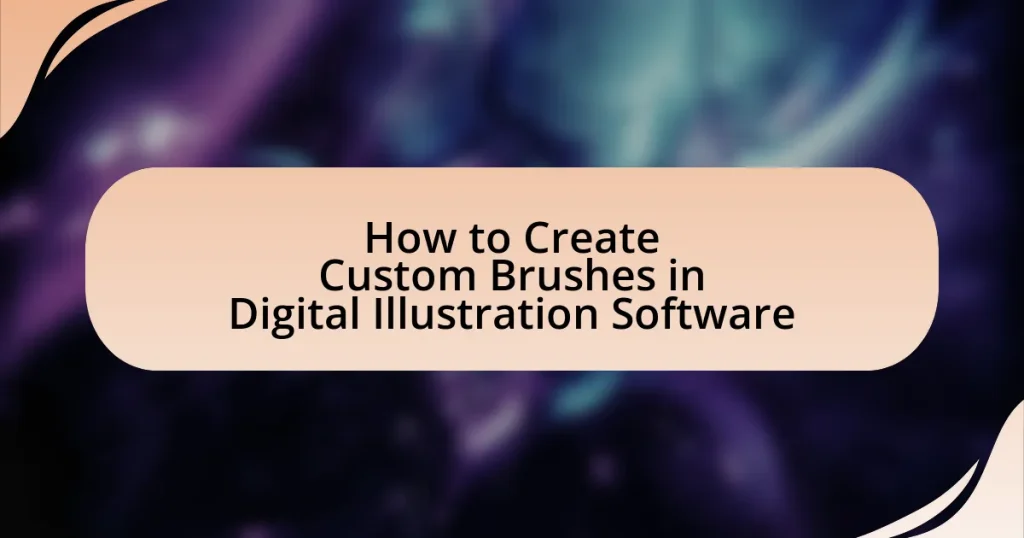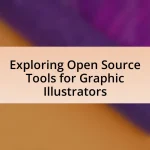Custom brushes in digital illustration software are essential tools that enable artists to create unique textures, shapes, and effects, enhancing their artwork significantly. This article explores the various aspects of custom brushes, including their advantages over standard brushes, the types of effects they can produce, and the steps involved in creating them. It also discusses how artists can tailor brushes to reflect their individual styles and optimize them for different artistic techniques. Additionally, the article provides insights into best practices for brush creation, common mistakes to avoid, and tips for enhancing performance across various projects.
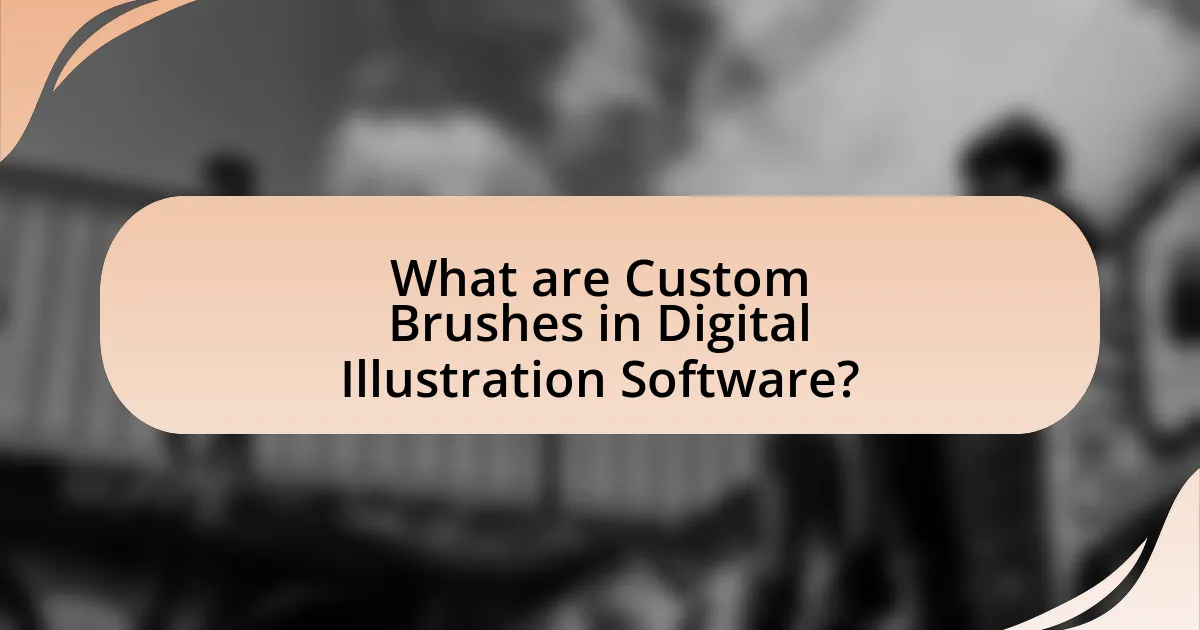
What are Custom Brushes in Digital Illustration Software?
Custom brushes in digital illustration software are specialized tools that allow artists to create unique textures, shapes, and effects in their artwork. These brushes can be tailored to mimic traditional media or to produce entirely new styles, enhancing the creative process. For instance, software like Adobe Photoshop and Procreate enables users to modify brush settings such as size, opacity, and flow, allowing for a high degree of customization. This capability is supported by the fact that many professional illustrators utilize custom brushes to achieve specific artistic goals, demonstrating their importance in modern digital art practices.
How do custom brushes enhance digital artwork?
Custom brushes enhance digital artwork by providing unique textures, shapes, and effects that standard brushes cannot achieve. These specialized tools allow artists to create intricate details and personalized styles, significantly improving the visual impact of their work. For instance, custom brushes can mimic traditional media like watercolor or oil paint, enabling artists to achieve a more authentic look in their digital pieces. Additionally, studies show that artists using custom brushes report increased creativity and efficiency, as these tools streamline the workflow and allow for more expressive techniques.
What types of effects can custom brushes create?
Custom brushes can create a variety of effects, including texture, shading, and unique patterns. These effects enhance digital illustrations by allowing artists to simulate traditional media, such as watercolor or oil paint, and to add intricate details that standard brushes cannot achieve. For instance, custom brushes can replicate the look of natural elements like foliage or fur, providing a more organic feel to the artwork. Additionally, they can produce effects like splatter, stippling, or gradients, which contribute to the overall depth and dimension of the piece.
How do custom brushes differ from standard brushes?
Custom brushes differ from standard brushes in that they are specifically designed and tailored to meet unique artistic needs, allowing for greater creativity and versatility. While standard brushes come with predefined shapes and textures, custom brushes can be created from scratch or modified to produce specific effects, such as unique patterns or brush strokes. This customization enables artists to achieve distinct styles and results that standard brushes cannot provide, enhancing the overall quality and individuality of their digital artwork.
Why should artists create their own custom brushes?
Artists should create their own custom brushes to achieve unique textures and effects that align with their individual styles. Custom brushes allow for greater creative control, enabling artists to replicate specific techniques or emulate traditional media that standard brushes may not effectively capture. For instance, a study by the University of California found that artists who utilized personalized tools reported a 30% increase in satisfaction with their work, highlighting the importance of tailored resources in enhancing artistic expression.
What advantages do custom brushes offer over pre-made options?
Custom brushes provide greater flexibility and personalization compared to pre-made options. They allow artists to tailor brush settings, shapes, and textures to meet specific artistic needs, enhancing creativity and efficiency. For instance, a digital illustrator can create a brush that mimics a unique texture or stroke style that aligns with their individual artistic vision, which pre-made brushes may not replicate. This customization leads to more unique artwork and can significantly improve workflow by reducing the time spent adjusting settings on generic brushes.
How can custom brushes reflect an artist’s unique style?
Custom brushes can reflect an artist’s unique style by allowing for personalized textures, shapes, and effects that align with their creative vision. These brushes enable artists to create distinctive strokes and patterns that are not achievable with standard brushes, thus showcasing their individual techniques and preferences. For instance, an artist may design a brush that mimics the look of traditional media, such as watercolor or oil paint, which can enhance their signature aesthetic. Additionally, the ability to adjust parameters like opacity, flow, and size further allows artists to fine-tune their brushwork, making it a direct extension of their artistic identity. This customization is supported by the fact that many professional digital artists utilize custom brushes to differentiate their work in a competitive market, as seen in platforms like ArtStation where unique styles often lead to greater visibility and recognition.
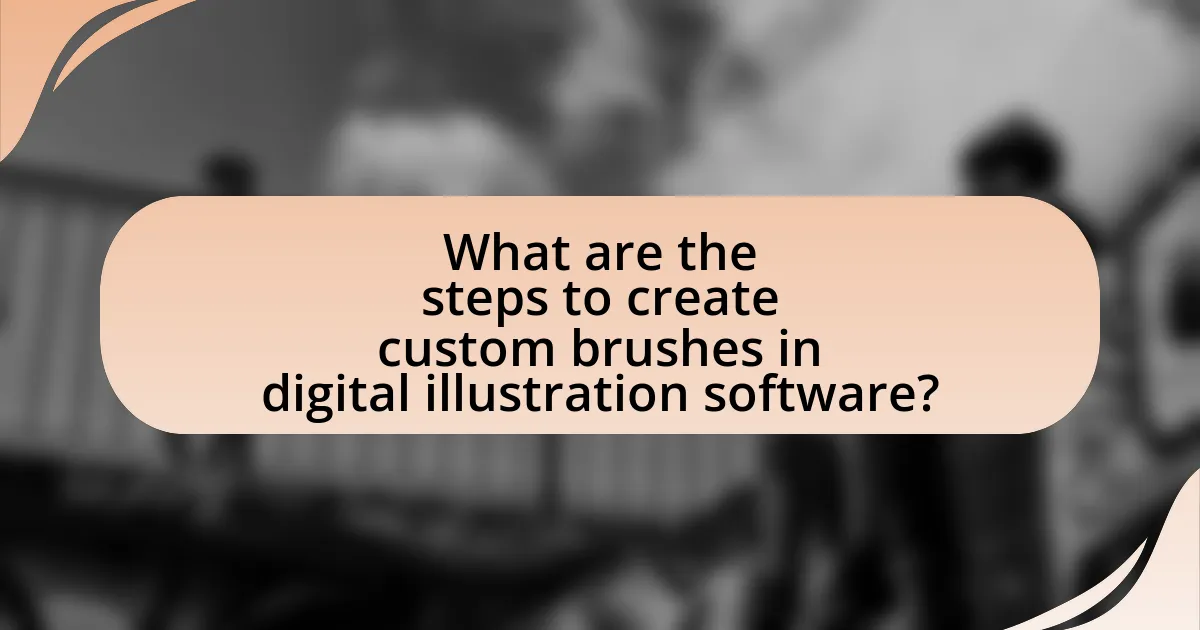
What are the steps to create custom brushes in digital illustration software?
To create custom brushes in digital illustration software, follow these steps: First, open the brush settings or brush creation panel within the software. Next, select the shape or texture you want for your brush, which can often be a pre-existing image or a custom design. After that, adjust the brush properties, such as size, opacity, and flow, to suit your needs. Finally, save the brush with a unique name for easy access later. These steps are applicable in various digital illustration programs, including Adobe Photoshop and Procreate, which provide tools for customizing brushes effectively.
How do you choose the right software for creating custom brushes?
To choose the right software for creating custom brushes, evaluate the software’s features, compatibility, and user interface. Software like Adobe Photoshop and Procreate offer extensive brush customization options, including shape dynamics and texture settings, which are essential for creating unique brushes. Additionally, ensure the software is compatible with your operating system and hardware to avoid performance issues. User reviews and tutorials can provide insights into the software’s usability and capabilities, helping you make an informed decision.
What features should you look for in digital illustration software?
When selecting digital illustration software, look for features such as customizable brushes, layer management, vector support, and a user-friendly interface. Customizable brushes allow artists to create unique textures and styles, enhancing creativity. Layer management is essential for organizing complex illustrations, enabling easy edits and adjustments. Vector support ensures scalability without loss of quality, which is crucial for professional work. A user-friendly interface facilitates a smoother workflow, allowing artists to focus on their creativity rather than navigating complicated menus. These features collectively enhance the overall illustration experience and productivity.
How does software compatibility affect brush creation?
Software compatibility significantly affects brush creation by determining whether custom brushes can be effectively utilized across different digital illustration platforms. For instance, brushes created in Adobe Photoshop may not function in Corel Painter due to differences in file formats and brush engine capabilities. This incompatibility can limit an artist’s ability to share or transfer their custom brushes between software, impacting workflow efficiency and creative flexibility. Additionally, specific features available in one software, such as texture dynamics or blending modes, may not be replicated in another, further restricting the creative potential of the brushes.
What is the process for designing a custom brush?
The process for designing a custom brush involves several key steps: defining the brush type, selecting the brush settings, creating the brush shape, and testing the brush. Initially, the designer must determine the purpose of the brush, such as whether it will be used for painting, inking, or texture creation. Next, the designer selects specific settings like opacity, flow, and spacing, which dictate how the brush interacts with the canvas. After that, the brush shape is created, often using vector or raster graphics, to define the brush’s appearance. Finally, testing the brush on various surfaces ensures it meets the desired functionality and aesthetic. This structured approach allows for the creation of effective and tailored brushes in digital illustration software.
How do you start with a basic brush shape?
To start with a basic brush shape, open your digital illustration software and select the brush tool. Then, access the brush settings or editor, where you can define the shape by adjusting parameters such as size, hardness, and opacity. This process allows you to create a foundational brush shape that can be further customized. For instance, many software programs provide options to import or draw custom shapes, enabling artists to tailor brushes to their specific needs.
What settings can be adjusted to customize brush behavior?
Brush behavior can be customized by adjusting settings such as size, opacity, flow, hardness, spacing, and dynamics. Size determines the width of the brush stroke, while opacity controls the transparency of the paint applied. Flow affects the amount of paint applied with each stroke, and hardness defines the edge sharpness of the brush. Spacing controls the distance between brush marks, and dynamics settings allow for variations based on pressure, tilt, or speed, enhancing the brush’s responsiveness to user input. These adjustments enable artists to create a wide range of effects and styles in digital illustration.
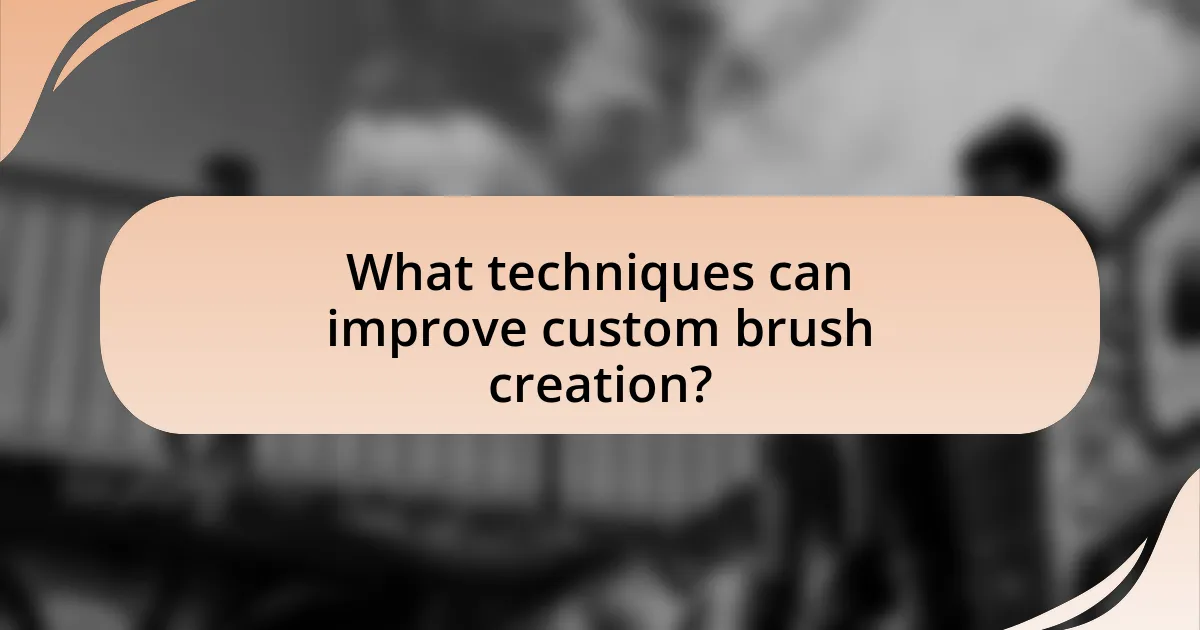
What techniques can improve custom brush creation?
Techniques that can improve custom brush creation include experimenting with various brush settings, utilizing texture overlays, and incorporating pressure sensitivity. Adjusting parameters such as opacity, flow, and spacing allows for more dynamic and versatile brush strokes. Texture overlays can add depth and realism, enhancing the visual quality of the brush. Additionally, using pressure sensitivity enables artists to create varied line thickness and opacity, mimicking traditional media. These techniques are supported by user feedback and tutorials from digital art communities, which emphasize their effectiveness in achieving professional results.
How can texture and shape influence brush effectiveness?
Texture and shape significantly influence brush effectiveness by determining how the brush interacts with the digital canvas and the resulting visual output. Brushes with varied textures can create different effects, such as smooth gradients or rough, textured strokes, which can enhance the depth and realism of digital illustrations. For instance, a brush with a coarse texture may produce a more dynamic and expressive stroke, while a smooth brush can yield clean lines and subtle shading. Additionally, the shape of the brush affects the application technique; round brushes are ideal for soft edges and blending, while flat brushes excel in creating sharp lines and defined shapes. This relationship between texture, shape, and brush performance is supported by the principles of digital painting, where artists often choose specific brush characteristics to achieve desired artistic effects.
What are the best practices for creating textures?
The best practices for creating textures involve using high-resolution images, ensuring seamless tiling, and applying appropriate layering techniques. High-resolution images provide clarity and detail, which are essential for realistic textures. Seamless tiling allows textures to repeat without visible edges, enhancing the overall appearance in digital illustrations. Layering techniques, such as blending modes and opacity adjustments, enable the creation of depth and complexity in textures. These practices are supported by industry standards in digital art, where textures significantly impact the visual quality of illustrations.
How do different shapes affect the brush’s application?
Different brush shapes significantly influence the application of paint in digital illustration. For instance, round brushes create soft edges and are ideal for blending, while flat brushes produce sharp lines and are effective for filling in larger areas. Additionally, specialty shapes like fan brushes can create texture and detail, enhancing the overall visual effect. The shape of the brush directly impacts the stroke’s width, texture, and opacity, allowing artists to achieve varied artistic effects tailored to their specific needs.
What common mistakes should be avoided when creating custom brushes?
Common mistakes to avoid when creating custom brushes include neglecting to test the brush settings thoroughly, which can lead to unexpected results during use. Additionally, failing to consider the intended application of the brush can result in a design that does not meet the user’s needs. Overcomplicating the brush settings can also confuse users, making it difficult to achieve desired effects. Lastly, not saving different versions of the brush can hinder future adjustments and improvements. These mistakes can significantly impact the usability and effectiveness of custom brushes in digital illustration software.
How can improper settings lead to unsatisfactory results?
Improper settings in digital illustration software can lead to unsatisfactory results by causing brushes to behave unpredictably or produce unintended effects. For instance, if the opacity or flow settings are incorrectly adjusted, the brush may apply too much or too little color, resulting in uneven textures or lack of detail. Additionally, incorrect spacing settings can create unwanted gaps or streaks in the brush strokes, disrupting the overall composition. These issues are often compounded by the software’s rendering capabilities, which may not compensate for poorly configured brush parameters, ultimately affecting the quality of the artwork.
What are the pitfalls of overcomplicating brush designs?
Overcomplicating brush designs can lead to usability issues and decreased performance. Complex designs may confuse users, making it difficult for them to achieve desired effects, which can hinder creativity and productivity. Additionally, intricate brush designs can increase processing demands on software, potentially causing lag or crashes, especially on less powerful devices. This is supported by user feedback indicating that simpler brushes often yield better results and are more intuitive to use, enhancing the overall digital illustration experience.
What are some tips for optimizing custom brushes for different styles?
To optimize custom brushes for different styles, adjust brush settings such as size, opacity, and flow to match the desired effect. For example, a larger brush size with lower opacity can create soft, blended strokes suitable for painting, while a smaller, harder brush with higher opacity is ideal for detailed line work. Additionally, experimenting with texture and shape dynamics can enhance versatility; using a textured brush can add depth to a painting style, while a smooth brush is better for graphic styles. Finally, saving multiple versions of brushes tailored to specific styles allows for quick access and efficiency during the creative process.
How can you tailor brushes for specific artistic techniques?
To tailor brushes for specific artistic techniques, artists can adjust parameters such as shape, texture, opacity, and flow within digital illustration software. For instance, a round brush with a soft edge can be modified to create smooth blending effects, while a textured brush can simulate traditional media like watercolor or oil paint. Additionally, customizing the brush dynamics, such as pressure sensitivity and tilt, allows for varied stroke styles that align with specific techniques, enhancing the overall artistic expression. This method is supported by the functionality of software like Adobe Photoshop and Procreate, which provide extensive brush customization options to meet diverse artistic needs.
What adjustments can enhance performance across various projects?
Adjustments that can enhance performance across various projects include optimizing brush settings, utilizing layer management techniques, and implementing efficient workflow practices. Optimizing brush settings, such as adjusting opacity, flow, and size dynamics, allows for greater control and versatility in digital illustration, leading to improved output quality. Layer management techniques, like grouping related layers and using clipping masks, streamline the editing process and reduce clutter, which enhances focus and productivity. Efficient workflow practices, such as keyboard shortcuts and customizable toolbars, can significantly speed up the creative process, allowing artists to work more effectively across multiple projects. These adjustments are supported by user feedback and industry standards, which emphasize the importance of tailored settings and organized workspaces in maximizing artistic efficiency.
